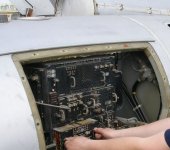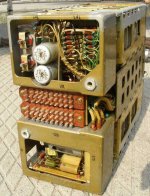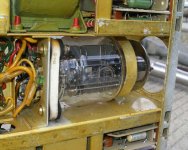ILIMZN I read carefuly about Trsat SE OTL amps(under` Description` Link You posted) and I hawe concludet next:Yes I sure that Trsat SE OTL Sounds Good,After all that Amps are OTL but NOT the OCL. But OCL termin is quit discutable even in OTL Circlotron topology beacose if We follow Path of the AC power generated from Cathodes of Output Power Tubes ,and circulated thru the Load(speaker),produced usefull Information(mostly Music)and continuet that path thru the smoothing Electrolytic CAPACITOR and finaly finished that path thru the Anode of Output Tubes,That AC Power Path is valid for Both Circlotron Phase, AC Power going vica-versa thru the LOAD(Speaker) and all smothing Capacitor and All Output Tubes. Some my expirence with 6c33c-b power triodeWell, if you truly want the lowdown od 6S33 and it's predecessors (6S19 is sort of half of a 6S33), there is one person that comes to mind with a wealth of knowledge on this subject. Look here:
Description
-plus sounds terrible, so forever is a really long time, and really off-topic.
You actually don't know what you are speaking about.
No amp sounds better than this one: http://www.diyaudio.com/forums/tube...-high-end-hybrid-amp.html?highlight=Tower-III
I am in agreement about the 6C33 not being for OTLs (just like 6SN7s and wire are not 'for' OTLs, but both seem to serve), and the exact same thing can be said of 6AS7Gs. They work fine in OTL circuits; the 6C33 does too, limited by its socket, which is also a problem in VR service. The Russian spec sheet called for a 750 hour service life, after which the socket was replaced as well.
In the old days, whenever we got a 6C33, it came in a box with the replacement socket. It took a while for the importer to figure out that he could remove the socket and charge separately for it.
I can second that, most of the data I have on the quirks of the 6S33S that the general public is not aware of, comes from a few people who used to service MIG aircraft here in 'Zavodi Zmaj' Croatia (military operated while it was still in the ex YU, and even then other countries that had them had them serviced here - it was later part privatized and still services aircraft today).
The socketing arrangement in the MIG module (the way these are made is very interesting in itself, cast out of some sort of foamed aluminium-magnesium-titanium alloy to make it strong and light) includes a top retainer and the heater pins are crimped and apparently soldered with a special alloy. When it's serviced, the tube and the socket is changed. The 750 hour limit is a maximum, it would often be exchanged earlier depending on how the aircraft ended up being rotated for service. Also, the tube is operated single-cathode, and you can switch them over as a redundancy feature. Operated single-cathode, it's actually an extremely reliable tube, but since everyone wants to save on the number of bulbs in a project...
ILIMZN I read carefuly about Trsat SE OTL amps(under` Description` Link You posted) and I hawe concludet next:Yes I sure that Trsat SE OTL Sounds Good,After all that Amps are OTL but NOT the OCL. But OCL termin is quit discutable even in OTL Circlotron topology beacose if We follow Path of the AC power generated from Cathodes of Output Power Tubes ,and circulated thru the Load(speaker),produced usefull Information(mostly Music)and continuet that path thru the smoothing Electrolytic CAPACITOR and finaly finished that path thru the Anode of Output Tubes,That AC Power Path is valid for Both Circlotron Phase, AC Power going vica-versa thru the LOAD(Speaker) and all smothing Capacitor and All Output Tubes.
I can only agree, which is why I tend to squirm whenever someone mentions the so-called 'signal path' through the amplifier. There is no such thing, if current loops are traced, some portion of the signal goes practically everywhere.
IOW pretty much the same thing you are commenting on. What I was commenting on was the very phenomena you are pointing to in your last paragraph above. We're on the same page, but use different nomenclature as I don't subscribe to the Voltage Paradigm vernacular- its too confusing for the layman, although in this case I think your explanation is better. What is amusing to me is that we have different conclusions from the same explanation
Output impedance is really a 'fiction' sort of thing if we look at it using a simple lumped-component ohms-law frame of reference - you can't point to a component representing it. However, it does behave that way. In fact, in your very amp, it's precisely the use of followers that demonstrates this very clearly - the inherent feedback is what gives it it's drive ability but only to the point where Rp does not interfere. Besides, Rp is also casued by inherent 'feedback' in triodes (caused by elecrons being less or more attracted by the plate depending on it's voltage relative to the cathode) - if you remove that property and get a pentode-like device where current is practically constant regardless of Vpk, you need to put external feedback (O. Schade style) around it to restore Rp.
I was just using the generally accepted terminology in electronics/electrical engineering. It has served me perfectly well so far
Some pics from MIG Airplane:
Can't you just smell it!!
Avionics have a certain scent .....and you just have to love all the engineering that went into those wiring harnesses.........looms for all!
Thank you for the memories
Of course there is the if you can see it there is still too much empty space aspect....
Last edited:
Tympany1d, I worked long time ago in Airplane Factory near Belgrade like maintanace Engenier(electronist).All thats Airplane comes later or sun on the Junk yard,but that Junk yard is good source for DIY parts(I by this things on the kilogram proportion for Cheap money).There is some proverb which sounds like:The BEST things in Life Man get for Cheap Money or for FREE. Good luck
Tympany1d, I worked long time ago in Airplane Factory near Belgrade like maintanace Engenier(electronist).
---//snip//---
Exactly as I'd surmised!
Darn surely wish we had those junk yards here!!!
the simulations for the m60 driver stage + 8x6c33c-b.
I think this is class AB.
If you use the same voltages of the stock M-60, most definitely. The mu of the 6C33 is higher, and will not require such a negative grid voltage value! Not only that, but the 6C33 does not allow for much in the way of grid current the way that the 6AS7G does.
Of course you will have other problems, like the need for matched quads at the very least, if you use the driver circuit without modification. I recommend, as stated earlier, a separate CF driver section (each with its own bias control) for each power tube.
LTSpice has no problem with K suffix but it interprets M as milli. For mega, use Meg
yep
If you use the same voltages of the stock M-60, most definitely. The mu of the 6C33 is higher, and will not require such a negative grid voltage value! Not only that, but the 6C33 does not allow for much in the way of grid current the way that the 6AS7G does.
Of course you will have other problems, like the need for matched quads at the very least, if you use the driver circuit without modification. I recommend, as stated earlier, a separate CF driver section (each with its own bias control) for each power tube.
i set the bias voltage for -60, 200mA each triode. is sufficient ?
as i'm intended to use 8 6c33c each channel (4 for phase), i need 4xCF each of them with an indipendent bias-balance control, that's right ? the best is to provide a sort of auto-bias, but i know there are troubles in the class-AB implementation.
thanks for the support
i set the bias voltage for -60, 200mA each triode. is sufficient ?
as i'm intended to use 8 6c33c each channel (4 for phase), i need 4xCF each of them with an indipendent bias-balance control, that's right ? the best is to provide a sort of auto-bias, but i know there are troubles in the class-AB implementation.
thanks for the support
Class of operation should have no bearing on an auto-bias circuit.
I...
An other matter that keeps bothering me is output impedance. How low is usually accepted in designs like these? Sice my speakers are 5ohm I'm thinking it's kind of important to me. Preferably it should be less than 1ohm but I don't know what's feasible?.... Tubes are a new and wonderful world to me.
If tubes are new to you then build a conventional design.
The typical output tube as an impedance of about 5,000 ohms. Yes that is 1,000 times higher then you want. the conventional design uses a transformer with a 1000 to one impedance ratio. (I'm using very "round" numbers.)
SO as your first project just keep it simple. Why not go for a conventional 5W single ended amp using easy to find in-expensive, stil in production tubes (like the 6V6) It will cost a 1/10th as much and have good sound.
Then buy a good very sensitive speaker. One rated at 100 dB will play nice (and loud) with your 5 WPC amp.
If tubes are new to you then build a conventional design.
The typical output tube as an impedance of about 5,000 ohms. Yes that is 1,000 times higher then you want. the conventional design uses a transformer with a 1000 to one impedance ratio. (I'm using very "round" numbers.)
SO as your first project just keep it simple. Why not go for a conventional 5W single ended amp using easy to find in-expensive, stil in production tubes (like the 6V6) It will cost a 1/10th as much and have good sound.
Then buy a good very sensitive speaker. One rated at 100 dB will play nice (and loud) with your 5 WPC amp.
The advantage of an OTL is there is no output transformer that you have to play with. But Chris is right- if you have not built a project before, an OTL is not the best place to start. OTOH, if you have built projects, just not tube ones, then maybe its not such a stretch.
If you are thinking of a 5 ohm speaker and a small OTL, a set of ZEROs is not a bad idea. Contrary to what a lot of people think when they hear something like this, the ZEROs do not counter the 'OTL qualities'. Consider that without an amp with no DC at the output and a relatively low output impedance, something like the ZERO (which has bandwidth to nearly 2 MHz) would not be possible.
In my case the building should not be an issue. It's not my first project per se but I haven't done any tube builds yet.
I guess one could say I'm doing a practice run with a circlotron buffer first before attacking the big project.
The hardest thing for a n0ob like me is the design bit. No or little experince makes it a challenge to pick the right component values even if you have a ready circuit.
atmasphere> Yes, the Zero's are a looking intersting, but we're not there yet. Build first worry about that later. It's great to know there is a fix for the impedance issue though.
I guess one could say I'm doing a practice run with a circlotron buffer first before attacking the big project.
The hardest thing for a n0ob like me is the design bit. No or little experince makes it a challenge to pick the right component values even if you have a ready circuit.
atmasphere> Yes, the Zero's are a looking intersting, but we're not there yet. Build first worry about that later. It's great to know there is a fix for the impedance issue though.
- Home
- Amplifiers
- Tubes / Valves
- What tubes for a OTL tube amp?


